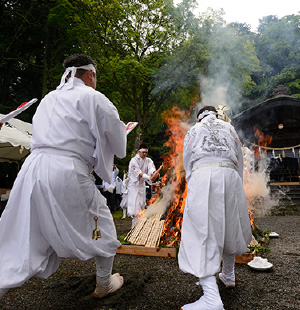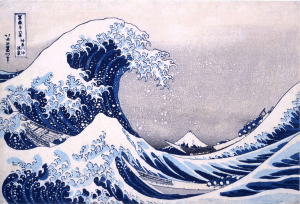Yamanashi Prefectural Fujisan World Heritage Center
World Heritage Site- Fujisan > Sacred place / Source of artistic inspiration
Main content starts here.
World Heritage Site- Fujisan
The sacred place/ the source of artistic inspiration
The sacred place
Fear of eruption, longing for Pure Land, hoping for rebirth -
Worship from afar, worship ascent, and pilgrimage ascent – the worship styles have varied over time.
The last record of the frequently occurred Fujisan’s eruption dates back to the 8th Century.
The style of worship Fujisan at that time was “worship from afar” by overlooking the top from the foot.
In order to pray to Asama God? (Asama no Okami?), a god of fire, for stopping eruptions, people established the Sengen-jinja Shrine at both mountain-foot provinces: the Kai (Shizuoka pref.) and Suruga (Shizuoka pref.).
After eruption stopped, the religious persons known as Shugensha (mountaineering ascetics) started considering Fujisan as their mountain ascetic practice place where God and Buddha resided, which became the origin of “tohai”, the worship ascent.
In the 12th century, Matsudai who had achieved over 100 times of “tohai” founded Fujisan Koboji Temple (Shizuoka pref.) and started a religious association called Fuji Shugen (Fuji mountain ascetic practices).
Since the 14th century, followers of the faith in Mt. Fuji came out also among commoners and they were called “doja”, who actively practiced “tohai” (worship ascent), aspiring to go to the Pure Land after death. People called "Oshi" to guide and take care of “doja” were also active.
In the 17th century, Fuji-ko, a religious association advocating Fujisan being the source of life, started. Also, “Junpai”, the pilgrimage to the sacred places at the slope or foot of Fujisan spread.
As the conversion of Fujisan worship into Shinto progressed in the 19th century, many statues of Buddha were removed from various places in the mountain areas. While on the other hand, the worship style was diversified. One of such examples is that the sacred sites once prohibited women became open also to women.
Entering the 20th century, many people visited Fujisan from Japan and abroad, which shows that the purpose of climbing Fujisan also has been diversified by including sightseeing. Still today, however, people continue to visit Fujisan with their respective feels for Fujisan.

The source of artistic inspiration
Fujisan in its majestic figure and shape has been the source of a variety of art activities.
Literatures such as "Manyoshu” (the 8th century waka poetry anthology) and “Taketori Monogatari” (The Tale of the Bamboo-Cutter)
Since the 14th Century, Fujisan was adopted as the theme of many paintings.
Painters representing Edo period such as Katsushika Hokusai and Utagawa Hiroshige created many beautiful ukiyoe themed on Fujisan.
The images of Fujisan depicted in ukiyoe were often used as motifs for Western arts in modern and contemporary periods. Not only had a profound influence on many works of art in the West, but they also took roots around the world as an icon symbolizing Japan and its culture.
After introduced to overseas, Fujisan pictures by these painters gave rise to an art movement called Japonism because of their innovative composition and mode of expression.
In the latter half of the 19th Century, as the Japanese isolation policy was abolished, Fujisan came to known not only as the “mountain representing Japan” but also as something with bigger implications.
Fujisan has been praised by many people throughout the ages. And it also continues to have the nature as the “source of artistic inspiration” by provoking artists’ desire for a variety of artistic and creative activities.

Copyright © 2016 Fujisan World Heritage Center all rights reserved.